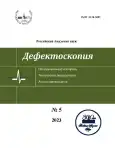The novel procedure of active thermal ndt: combining heating and forced cooling
- Authors: Chulkov A.O1, Vavilov V.P1, Shagdyrov B.I1, Kladov D.Y.1, Stasevskiy V.I1
-
Affiliations:
- National Research Tomsk Polytechnic University
- Issue: No 5 (2023)
- Pages: 54-63
- Section: Articles
- URL: https://journals.rcsi.science/0130-3082/article/view/144351
- DOI: https://doi.org/10.31857/S0130308223050068
- EDN: https://elibrary.ru/ZGAEXS
- ID: 144351
Cite item
Full Text
Abstract
About the authors
A. O Chulkov
National Research Tomsk Polytechnic University
Email: chulkovao@tpu.ru
Tomsk,Russia
V. P Vavilov
National Research Tomsk Polytechnic UniversityTomsk,Russia
B. I Shagdyrov
National Research Tomsk Polytechnic UniversityTomsk,Russia
D. Yu. Kladov
National Research Tomsk Polytechnic UniversityTomsk,Russia
V. I Stasevskiy
National Research Tomsk Polytechnic UniversityTomsk,Russia
References
- Rani A., Mulaveesala R. Novel pulse compression favorable excitation schemes for infrared non-destructive testing and evaluation of glass fibre reinforced polymer materials // Composite Structures. 2022. P. 286.
- Švantner M., Muzika L., Moskovchenko A., Pereira C.M.C., Das S. Infrared Physics and Technology. 2022. P. 126.
- Alhammad M., Avdelidis N.P., Ibarra-Castanedo C., Zolotas A., Maldgue X.P.V. Automated impact damage detection technique for composites based on thermographic image processing and machine learning classification // Sensors. 2022. V. 22 (23). P. 9031.
- Ward C., Burleigh D. Pulse thermography applications in aerospace composites manufacturing processes // Proceedings of SPIE - The International Society for Optical Engineering. 2020. V. 11409. P. 114090J.
- Maldague X. Theory and practice of infrared technology for nondestructive testing / Wiley Series in Microwave and Optical Engineering. New York: John Wiley & Sons, 2001.
- Grys S. Determining the dimension of subsurface defects by active infrared thermography - experimental research // Journal of Sensors and Sensor Systems. 2018. V. 7. P. 153-160.
- Maillet D., Andre S., Batsale J-C., Degiovanni A., Moyne C. Thermal Quadrupoles: solving the heat equation through integral transforms. England: John Wiley & Sons Publisher, 2000.
- Moskovchenko A., Švantner M., Muzika L. Infrared thermographic method for depth characterization of low size/depth aspect ratio defects in metal parts / 31st International Conference on Metallurgy and Materials, METAL 2022. 2022. P. 481-486.
- Cramer K., Perey D.F., Brown J.L. The application of line scan thermography using multiple collaborative robots / Review of Progress in Quantitative Nondestructive Evaluation. 2019. Portland, USA. P. 4.
- Chulkov A.O., Tuschl C., Nesteruk D.A., Oswald-Tranta B., Vavilov V.P., Kuimova M.V. The Detection and Characterization of Defects in Metal / Non-metal Sandwich Structures by Thermal NDT, and a Comparison of Areal Heating and Scanned Linear Heating by Optical and Inductive Methods // Journal of Nondestructive Evaluation. 2021, V. 40 (2). P. 44. doi: 10.1007/s10921-021-00772-y
- Chulkov A.O., Vavilov V.P., Nesteruk D.A., Burleigh D., Moskovchenko A.I. A method and apparatus for characterizing defects in large flat composite structures by Line Scan Thermography and neural network techniques // Frattura ed Integrita Strutturale. 2023. V. 17 (63). P. 110-121.
- Chulkov A.O., Vavilov V.P., Nesteruk D.A., Shagdyrov B.I. Thermal flaw detection scanner for testing large-sized flat products made of composite materials // Russian Journal of Nondestructive Testing. 2022. V. 58. No. 4. P. 301-307.
- Вавилов В.П. Инфракрасная термография и тепловой контроль. М.: ИД "Спектр", 2015. 545 с.
Supplementary files









